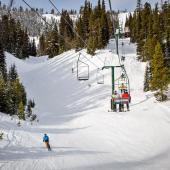BBC News
The Bridger Bowl Cloud affect.
Every so often, a blue light flashes on top of the Baxter Hotel, alerting anyone within view of the tallest building in Bozeman that snow is falling at Bridger Bowl. The light—a repurposed airport runway strobe that flashes for 24 hours when the ski area receives at least two inches of snow—was installed in 1988 and played an important role before the era of the Internet. It’s related to an isolated weather phenomenon affectionately called the BBC, or Bridger Bowl Cloud, which descends like a blanket over the east-central Bridger Mountains and leaves behind a prodigious amount of snow.
“Because of the BBC, we’d get these isolated snowstorms and get a bunch of snow in the mountains, but nothing was going on in town, so people wouldn’t know,” says Doug Wales, marketing director for Bridger Bowl. “So in the ‘olden days,’ the flashing blue light is how people would become aware it was snowing at Bridger.”
According to Eric Knoff, an avalanche specialist with the Gallatin National Forest Avalanche Center, the BBC is a “sneaker” and can drop up to 36 inches of snow at Bridger, while only one or two inches end up in town. Don’t be fooled by the clouds pouring over the ridgeline and seeping into the valley—the true BBC is the one that drops loads of snow, says Knoff.
It’s hard to predict when the mysterious cloud and its revered powder-pouring abilities will occur, but January tends to be a good month for the cloud. During some seasons, the BBC appears half a dozen times, and during others only once or twice, according to Knoff. Last season, despite the thick cloud that frequently obstructed the view of the mountains from town, there was only one cycle of the BBC, when a white blanket fell over the mountain and the Bridgers saw 30 inches of snow in just a few days. It’s times like these, says Knoff, laughing, that “Big Sky has BBC envy.”
The BBC’s beloved snow load is actually not caused by a cloud at all, but rather a weather event called “upslope precipitation,” says Megan Vandenheuvel, a meteorologist for the National Weather Service in Great Falls. The snow starts to fall when a cold, moist northwestern air flow moves through the canyon and is forced upward by the unique geography of the mountains, creating precipitation in the higher elevations.
Regardless of how it forms or what it’s called, the BBC and its isolated snow showers are, at least in part, responsible for the current location of Bridger Bowl. The weather pattern was considered when the ski area moved from its lower elevation at Bear Canyon in the mid-1950s. It’s a unique phenomenon related to the particular geography of the mountains, and interest in the “cloud” is representative of the enthusiasm locals have for the landscape and the outdoors.











